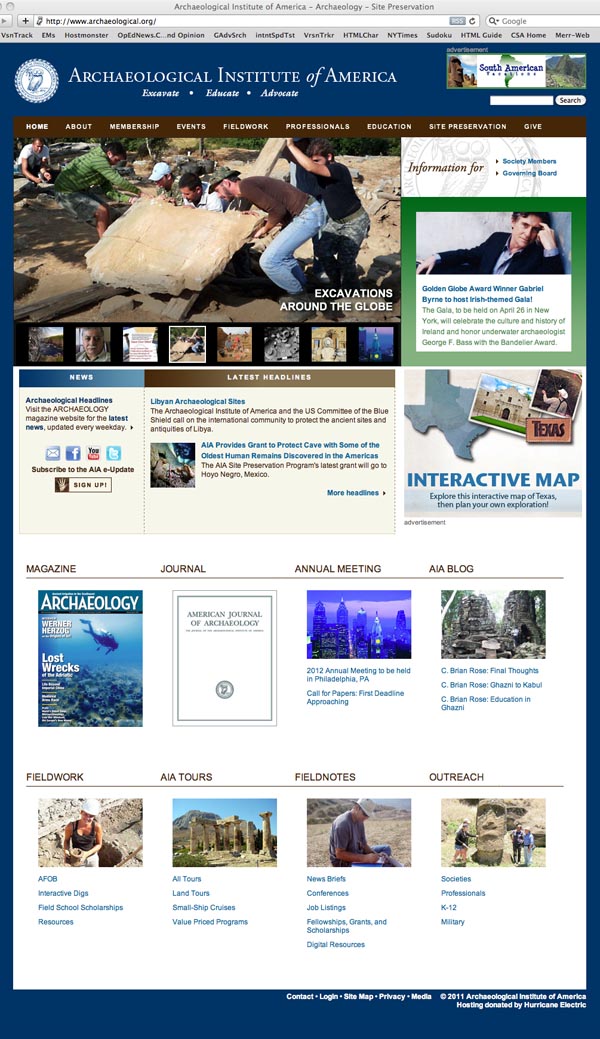

| Vol. XXIV, No. 1 | April, 2011 |
Articles in Vol. XXIV, No. 1
Project Publication on the Web — II
What are the motivating factors?
-- Andrea Vianello, Intute and Harrison Eiteljorg, II
Website Review: Archaeological Institute of America
The AIA's redesigned website.
-- Phoebe A. Sheftel
Website Review: Kerma
An archaeological project from Africa on the web.
-- Andrea Vianello, Intute
Calibration or Ground-Truthing Is Critical
Confidence in analyses requires confidence in the base data.
-- Harrison Eiteljorg, II
Let Us Set the Mental Juices Flowing
Artifacts should tell a story, not be the story.
-- Harrison Eiteljorg, II
To comment on an article, please email
the editor using editor as the user-
name, csanet.org as the domain-name,
and the standard user@domain format.
Index of Web site and CD reviews from the Newsletter.
Limited subject index for Newsletter articles.
Direct links for articles concerning:
- the ADAP and digital archiving
- CAD modeling in archaeology and architectural history
- GIS in archaeology and architectural history
- the CSA archives
- electronic publishing
- use and design of databases
- the "CSA CAD Layer Naming Convention"
- Pompeii
- pottery profiles and capacity calculations
- The CSA Propylaea Project
- CSA/ADAP projects
- electronic media in the humanities
- Linux on the desktop
Website Review: Archaeological Institute of America
Phoebe A. Sheftel
(See email contacts page for the author's email address.)
Archaeological Institute of America
- URL: http://www.archaeological.org/
- Authorship: The web site of the Archaeological Institute of America contains material that may be accessed and used within the limits of it copyright protections. There is no indication given as to the authorship of much of the material on the site.
- Site host: Hurricane Electric, Freemont, CA
- Peer review, permanence: No statements appear as to peer review policies on information of a scholarly nature. There are a few statements about its provisions for archiving certain content, those few about specific items, not the site as a whole. The web site contact is website@aia.bu.edu
- Site maintenance: A major intent of the web site is to provide the latest information on developments in the field. Some entries are dated; some listings (job openings, museum exhibits, etc.) are well past their expiration date. Other parts are geared to present more permanent information on the AIA's structure, governance and policies.
In September 2010 the AIA announced the redesign of its web site, made possible by members' donations. The quantity of print and video material suggests it was a costly project but one that was well worth the expense in light of the comprehensive range of information the site offers.
Audience
A fundamental question that any site developer needs to consider is: "Who is our audience?" In this case, the AIA has set itself the goal of responding to a very wide-ranging group of potential users: professional archaeologists, graduate students, secondary school teachers, members of the public interested in and supportive of archaeology, prospective AIA members, active military and the press. The site is quite successful in anticipating the users' wants and supplying a vast amount of information. In fact, there is so much information placed in 48 pages accessible from the banner menu bar, let alone other places on the site you many stumble upon, that some real treasures are only found by accident – somewhat analogous to the thrill of excavating a site.
Home Page
The site is done in a handsome palette of colors. The primary focus on the Home Page is a central window with a rotating group of eight images that highlight significant topics and allow one to link directly to detailed information. When this review was written, the images featured the upcoming gala event, membership information, opportunities to contribute to site preservation, excavations, Archaeology magazine, the American Journal of Archaeology, tours and the annual meeting.
A section of the Home Page features Latest Headlines about archaeological news with links to a longer list ranging back over several months. Most of the listed news items covered organizational events or encouragement to support various policy initiatives. Another box contains a link to Archaeology magazine's site where you can find news stories about more archaeological topics. (Though the Archaeology site is linked from this page and others on the AIA site, the magazine site is technically separate and has its own URL.) Back on the AIA's Home Page there are places to sign up for e-News updates, send an email to the AIA, connect to the AIA's Facebook page, link to You Tube videos through Archaeology magazine's web site and connect via Twitter (where the AIA boasts 730 followers).
At the bottom of the Home Page are eight large graphics representing major sections of the site for easy links directly to a desired location, with sub-headings to allow you to get directly to the right place within a section: MAGAZINE, JOURNAL, ANNUAL MEETING, AIA TOURS, FIELDWORK, AIA BLOGS, FIELDNOTES and OUTREACH. A pared-down group of four such icons appears at the bottom of the page for each major section of the site, with the topics geared to the subject covered in that section. I see the icon links at the bottom of the page somewhat akin to the search for a book on Amazon. Once you have reached your chosen destination, there are suggestions of other books you might want to consider, based on your interest in the topic of your original search book. On the AIA site, however, most of the suggested links are aimed at getting you to join or contribute to the AIA.
A permanent banner menu bar across the top of the page directs you around the site based on another set of options: ABOUT, MEMBERSHIP, EVENTS, FIELDWORK, PROFESSIONAL, EDUCATION, SITE PRESERVATION, and GIVE. It is these menu sections that serve as the basis for this review of the site.
Two special links are provided at the top of the Home Page. Governing Board members get a convenient link to a password-protected part of the site and all users are easily directed to information on locating and joining a local society or searching for lectures hosted by a local society.
The ads (labeled as such) are relatively small, and the graphics harmonize with the overall look of the page.
The site is effectively divided into eight section by the Home Page banner. Seven of those eight sections will be considered in turn here; the section about giving to the AIA will not be discussed.

About
In addition to the Home Page, each of the nine banner menu pages contains a variety of appealing topic boxes that lead you deeper into the subject. For instance, the About page gives you the opportunity to delve into the contents of the AIA archives (leading you to a copy of the original charter of 1906) or expand on the AIA's mission statement through viewing an engaging short video in which several scholars, AIA officers and staff address the question "What is Archaeology?" as a way of explaining the AIA's goals: excavate, educate and advocate. These are not simply talking heads; the viewer is engaged through a cycle of beautiful photos and sometimes soaring background music.
Many times you find yourself encountering interesting material, such as a box on the History page where you can access copies of the AIA Bulletin, the Institute's annual report. Unfortunately, the current listing only goes up to the 2006 Bulletin.
Whatever page you happen to land on, there are certain to be boxes and icons along the side or at the bottom that allow you to jump to various other places, some of which relate to the main topic of the page and others that entice you to become a member, attend an event, subscribe to a magazine or purchase an AIA item. These enticements are not intrusive; but designed into the overall site layout so well they illustrate the smooth blend of scholarly information and organizational marketing that characterizes the site.
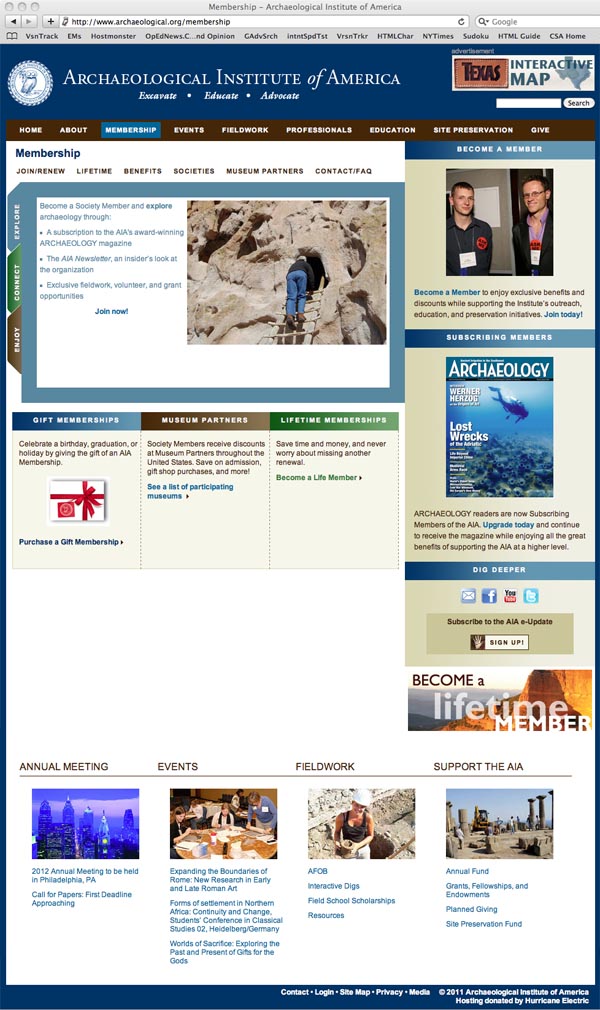
Membership
Potential members can join online and use an interactive map to discover the closest society. Some society links are more informative than others, but each has an email link to the designated representative, so you can contact them directly for program details. To get to a list of lectures offered by a local society, it is best to go through the Events page, where there is a menu item LECTURES. Details on the lecture provide both biographical information about the lecturer and an abstract of the talk.
A number of places on the site offer opportunities for users to supply information that will enhance the content of the site. The Membership page features one example: museums are urged to become partners with the AIA by completing a simple form. This partnership is mutually beneficial – providing publicity for the museum and discounted entrance fees as a benefit for AIA members.

Events
In addition to the listing of lectures, searchable by speaker's name or talk location, other listings are grouped under archaeological fairs (appealing to families with young children), workshops and conferences. A search capability lets you find an offering by keyword. As another example of the site's feedback format, academic departments or groups sponsoring lectures or programs can submit information for listing in the UPCOMING EVENTS section.
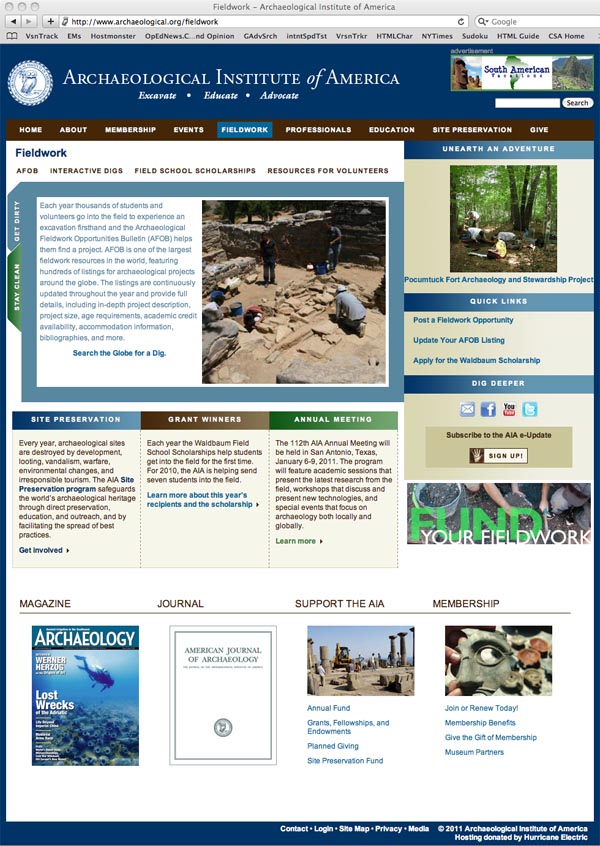
Fieldwork
The long-popular Archaeological Fieldwork Opportunities Bulletin is presented as a convenient interactive tool that lets you search for dig experiences by country, designating whether you want to locate a staff position, a field school program or work as a volunteer. (Prospective volunteers should be aware that there is frequently a charge to cover room and board expenses while working on an excavation.) There are resources to prepare the volunteer excavator for the dig experience and to learn about responsible archaeological tourism.
The INTERACTIVE DIGS section takes you over to the web site for Archaeology Magazine where you can engage in the dig experience, such as the Zominthos Project on Crete. Armchair archaeologists will enjoy reading weekly reports from the trenches, taking a video tour of the site, hearing what it's like to work on the site, learning details about interesting finds and even submitting their own suggestion about the original purpose of an unusual object.
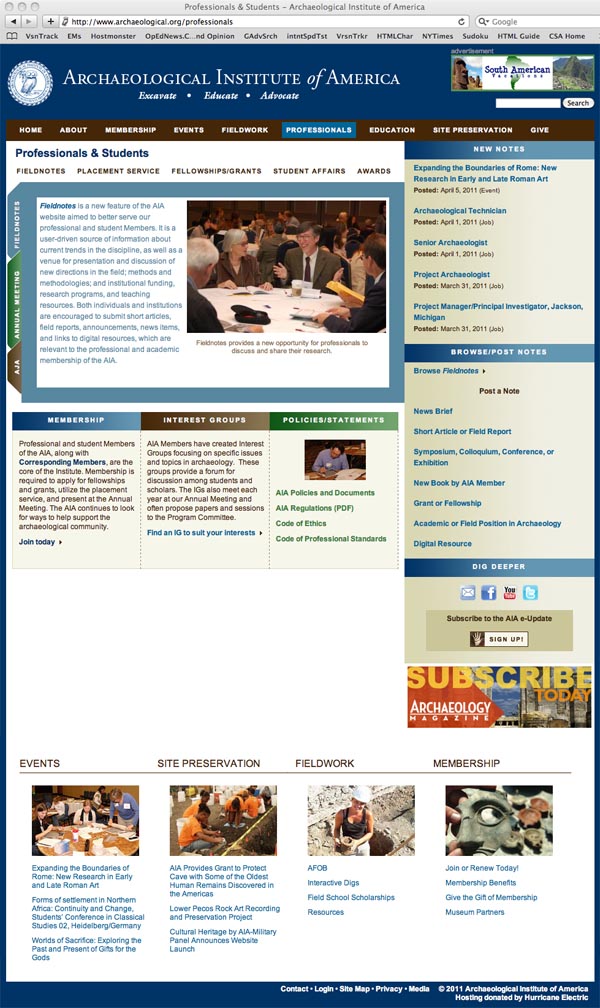
Professionals
This section, geared toward professionals and rising graduate students, highlights a new feature called FIELDNOTES, described as "a user-driven source of information about current trends in the discipline, as well as a venue for presentation and discussion of new directions in the field; methods and methodologies; and institutional funding, research programs, and teaching resources." A note states that the "pages are additive and postings are updated weekly and permanently archived." (Both quotations from http://www.archaeological.org/professionals; last accessed 4/7/11.) This appears to be the go-to place for most professional users of the site.
Fieldnotes is a treasure trove of resources that relies largely on the archaeological community to update it with new information. There are listings covering news briefs (links to items of interest on other web sites), short articles and field reports (only two postings, one of which might benefit from some peer review), listings of conferences and exhibits, new books by AIA members, recently completed Ph.D. dissertations, information on grants and fellowships, and academic and field positions. Relying, as they do, on information provided by outside users, the unstated implication is that these listings may not be complete or comprehensive.
For some reason the list of Recent and Upcoming Symposia starts with the oldest listings that tend to be out of date (9 of the 10 events shown on the first page were held in the past.) This is an example of how the attempt at being dynamic and current creates the need for constant updating. Likewise for the list of museum exhibits. Two of the five listings give open and closing dates for special showings, but three simply give a single date and then, when you click to the more detailed listing, you get only the rather cryptic information that the show will be at 4:00 am. If you go to the museum's web site through the link provided, you learn that the exhibit closed months ago. Since the AIA site conveniently offers outside users the opportunity to post information to most of the Fieldnotes categories, some of these lapses may be ascribed to the person entering the data. It might be helpful to include a field in the entry form that asks the poster when the data will become obsolete so the AIA can add those dates to its "to do" list for site maintenance.
A list of digital resources covers academic and research programs, museums and libraries, bibliographies and databases, discussion groups, book reviews and professional societies. While very comprehensive, these lists seem to omit some well-known resources. At a quick glance, several examples of missing information caught my eye: Bryn Mawr College's undergraduate major in archaeology, the Getty Museum, the research library of the University of Pennsylvania Museum of Archaeology and Anthropology, the Center for the Study of Architecture and its CSA Newsletter.
Job placement information consists of listings of available positions (with connections to The American Philosophical Association web site's list of positions in both archaeology and classics) and grants, along with links to other resources useful for the job seeker.
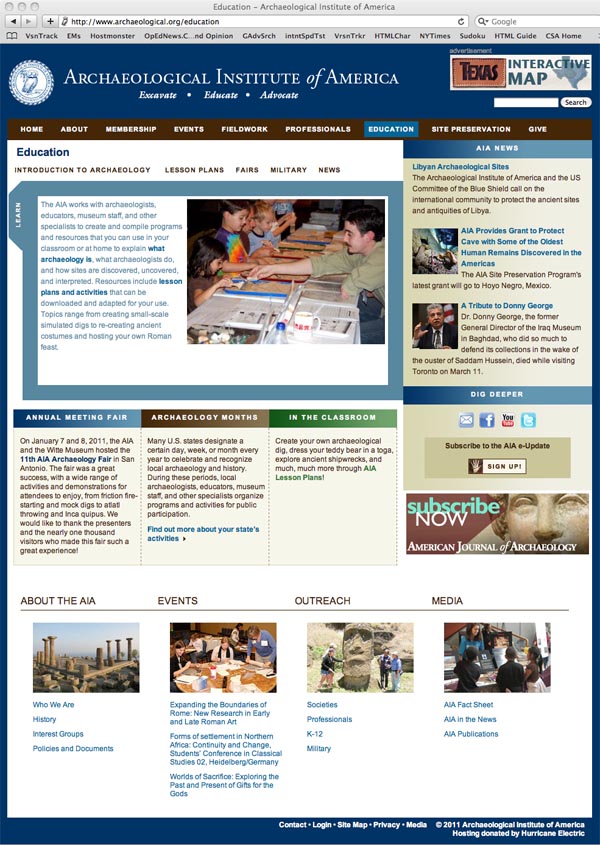
Education
The Education section is the most fun, with ideas for school projects ranging from classroom excavations to a Roman banquet, complete with recipes for glazed dormice and the favorite Roman ketchup-equivalent sauce, liquamen, concocted from unappetizing ingredients like fish blood and intestines left out in the sun to ferment for at least 20 days. Several videos walk teachers through the purposes and processes of creating various dig scenarios for classroom experiences. The information goes beyond the fun factor and illustrates how the critical thinking and recording skills gained through engaging in a classroom dig are transferable to other parts of the curriculum like math, art and writing.
A section of the Education page is devoted to the cooperative links forged between the AIA and the US military active in important archaeological regions in the Mediterranean and the Near East. There is a link to a special site devoted to CHAMP, the Cultural Heritage by AIA-Military Panel, which seeks to prepare military personnel for the challenges of dealing with local culture and history when posted overseas.

Site Preservation
This topic has a section of its own, with useful information on site preservation funding sources within the AIA and through other institutions. Probe deeply enough and you will come across a fascinating article, "The Reconstruction of Ruins: Principles and Practice" by Nicholas Stanley-Price. This is an overview that might also be interesting to people contemplating taking one of the many tours offered by the AIA, along with the "Guide to Best Practices for Archaeological Tourism" located on the Fieldwork page.
Some Attention Needed
Some pages offer helpfully detailed information, such as the list of AIA committees with the name of the overseeing officer and the chair. While this can be useful, it also adds to the constant task of updating when new people are elected to positions. (As of the end of March, the list had not been changed to reflect position changes resulting from the Annual Meeting held in early January.)
The site was viewed in both Internet Explorer and Firefox. In both cases there are occasional problems with some odd font characters that appear in place of quotation marks and other grammatical symbols, as well as accented letters in words in foreign languages.
All the links explored on the site led to the intended destination, except for the link on the page http://www.archaeological.org/interestgroups (accessed via the About page), where the "click here" link (in the last paragraph of text), promising "more information on how to create a new IG or to learn what is expected of an Interest Group," led instead to the site map on which the words "Interest Group" do not appear.
Overall, the new AIA site appears to meet its implicit goals and address the needs of its varied audiences. Keeping it fresh and current will be key to its success.
-- Phoebe A. Sheftel

All articles in the CSA Newsletter are reviewed by the staff. All are published with no intention of future change(s) and are maintained at the CSA website. Changes (other than corrections of typos or similar errors) will rarely be made after publication. If any such change is made, it will be made so as to permit both the original text and the change to be determined.
Comments concerning articles are welcome, and comments, questions, concerns, and author responses will be published in separate commentary pages, as noted on the Newsletter home page.
